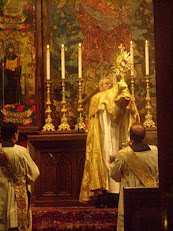
The Papal Basilica of St. John Lateran is the Cathedral Church of the Pope, the Bishop of Rome (despite St. Peter's oft-mistaken identity thereas). Today, the feast of its dedication is a feast of the whole Latin Church, because this Church is the Mother Church of all Latin Christendom. It is also, of course, the one year anniversary of the publication of Anglicanorum coetibus.
Fr. Hunwicke has an Illuminating post the reveals the connections between Rome and Canterbury, which I quote below:
When S Augustine came to Canterbury, he built a cathedral church In honore Sancti Salvatoris. In other words, he gave it the same dedication as that of the papal cathedral church in Rome, the Lateran basilica, the Mother Church of the world. Later, just as Rome had the basilicas of Ss Peter and Paul, outside the walls because they were built on the sites of the cemeteries where the Apostles were buried (Roman burials were always outside city walls), so Canterbury was to have the great monastery of Ss Peter and Paul (vulgo S Augustine's), outside the city walls, where burials took place. And, to represent Great S Mary's in Rome, to the East of Ss Peter and Paul was the church of our Lady.
Nostalgia, nostalgia. Today's commemoration of the Dedication of the Lateran Basilica is marked surely with tears for Anglican Catholics as we lament the ruin of the great Ecclesia Anglicana which, from her beginning, was a beacon and monument of Romanitas in these damp and misty islands of the North, at a time when distinctively Roman Christianity had not yet spread much further that Rome herself. As Blessed John Henry put it, Canterbury has gone its way, and York is gone, and Durham is gone, and Winchester is gone. It was sore to part with them. We clung to the vision of past greatness, and would not believe it could come to nought ... but the vivifying principle of truth, the shadow of S Peter, the grace of the Redeemer has left it. That old Church in its day became a corpse (a marvellous change!) and then it did but corrupt the air it once refreshed and cumber the ground which once it beautified.
Romanitas is, of course, still in the news. The Ordinariate will be directly under the Bishop of Rome himself; the Ordinary will be a Vicar of the Sovereign Pontiff. There may be those who see this as a sign of the Romanitas of Augustinian Canterbury in the centuries of its greatness and of its now departed glory, when the Primate was Legatus natus Sanctae Sedis. Another sentence of Newman's springs to mind: "A pledge to us from Rome of Rome's unwearied love".
The Vatican web site now has links to sites for all the Papal Basilicas, and so for those who can't be in Rome itself for this festival, here is the Virtual Tour of the Lateran Basilica.














No comments:
Post a Comment